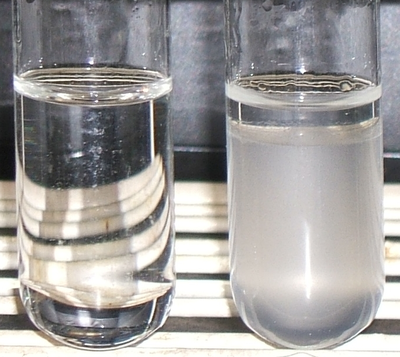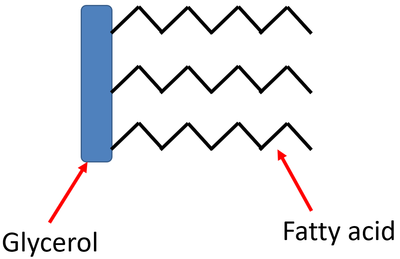Key Stage 3
Meaning
Lipids are molecules found in fats and oils.
About Lipids
- Oil is better for us than fat, but we need some of both.
- If we eat too much fat and oil then we can become obese.
These foods contain a lot of fats and oils.
|
|
|
|
|
|
| Meat contains useful fat for our diets, but too much can lead to heart disease.
|
Fish is a very healthy source of oils in our diet.
|
Nuts are a healthy source of oils.
|
Butter is full of fat and we shouldn't eat too much. Butter is found in cakes and cookies.
|
Cooking oil is used to fry our food causing it to have a lot of oil inside it. A small amount is healthy but too much is bad for us.
|
Testing For Lipids
- Adding lipids to paper can turn the paper translucent.
The Paper Test Method
- 1. Take a small sample of food.
- 2. Wipe it on a piece of paper.
- 3. Hold the paper up to the light.
- 4. If the paper has turned translucent the food contained lipids.
|
|
| There are two patches where fat has been asborbed by the paper.
|
The Alcohol Emulsion Test Method
- 1. Take a small sample of food.
- 2. Place the food in ethanol and mix by shaking or stirring.
- 3. Filter the mixture.
- 4. Add the clear solution to some water.
- 5. If lipids are present then a white emulsion will appear.
|
|
| The mixture on the right shows the presence of lipids.
|
Key Stage 4
Meaning
Lipids are molecules, made of a glycerol head and 3 fatty acid tails, that is found in fats and oils.
About Lipids
- Lipids are an essential nutrient in our diet that is used in our nervous system.
- Lipids store chemical energy at a higher energy density than carbohydrates so the body stores extra energy in fatty tissue made of lipids.
- If there are too much lipids in our diet then we can become obese.
- Lipids are broken down by our digestive system into a glycerol head and 3 fatty acid tails.
- The fatty acids in lipids can be many different lengths.
Testing For Lipids
- Adding lipids to paper can turn the paper translucent.
The Paper Test Method
- 1. Take a small sample of food.
- 2. Wipe it on a piece of paper.
- 3. Hold the paper up to the light.
- 4. If the paper has turned translucent the food contained lipids.
|
|
| There are two patches where fat has been asborbed by the paper.
|
The Alcohol Emulsion Test Method
- 1. Take a small sample of food.
- 2. Place the food in ethanol and mix by shaking or stirring.
- 3. Filter the mixture.
- 4. Add the clear solution to some water.
- 5. If lipids are present then a white emulsion will appear.
|
|
| The mixture on the right shows the presence of lipids.
|
Beyond the Curriculum







